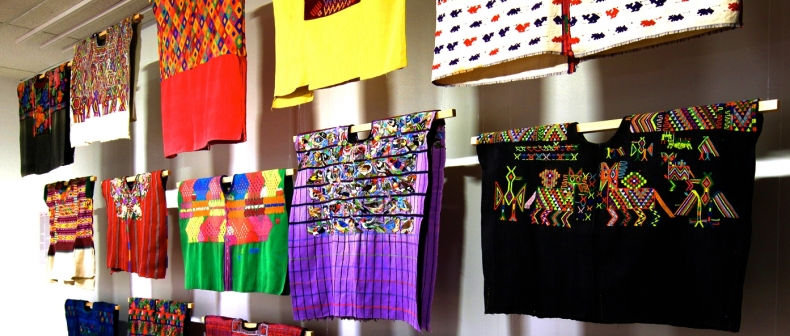
You would think the Executive Director of the Textile Museum of Canada would have earned her position by being the master of all things textiles. But Shauna McCabe has a different story.
“Actually, I was not in textiles at all.” While she was working on her PhD in Geography (her Masters was in Communications and Cultural Studies) she went from Vancouver to Charlottetown to curate a show at the Confederation Centre Art Gallery: “I started on one show and I ended up as senior curator there for eight years.” Although she had never studied it, she discovered that curating was what she wanted to dedicate her life to. It was the perfect combination of her interests in creative production, the philosophy of spaces, and public dialogue.
“I love that museums are about the public. Public engagement doesn’t happen by itself. It happens because you have content there,” says McCabe.
When she arrived at the Textile Museum in 2010, she discovered her curatorial skills and experience relating ideas through cultural products easily transferred to textiles. Founded in 1975 in Mirvish Village above an ice cream shop, the basis of the museum’s collection were textiles collected by businessmen during their travels. Since then it moved to its current location near University and Dundas and the collection grew to about 13,000 objects from more than 200 countries.
“The volunteers actually built this museum,” McCabe says, and feels highly indebted to them and the curators already at the museum. But when she came onboard, she realized a director who spoke to the bigger picture was needed to connect the collection to the globalized world. What Toronto lacks in historical buildings it makes up for in the everyday objects that tell the tale of people’s lives.
“There are always unique histories and unique cultures with any artifact, whether it’s contemporary art or historical textiles. It’s about pulling out the stories in them and contextualizing it for people so they can bring their own experiences to it.”
Because textiles are so wrapped in culture and tradition, the museum has a long history of working closely with various communities on its exhibitions, often starting with an advisory committee. While working on the exhibit ‘Dare to Wear Love’ in 2012, in which Canadian designers created original pieces to benefit the Stephen Lewis Foundation, the community McCabe had to connect to was the fashion one.
“It was the first time a lot of the fashion community had been in the museum, which shocked me because you’d think fashion and textiles are connected, and you’d think they’d want to use this as a resource.”
I ask her why she thought there might be a disconnect between the museum and the industry.
“I think it’s in general with cultural institutions,” she answers. “People go to the museum, but they don’t make it part of their everyday lives. That’s what I’m trying to change here.”
To do that, McCabe is trying to break through the museum’s physical walls and conquer the digital world. Last year, working with Year Zero One and [murmur] the museum launched TXTilecity, a website and app that looks at the history of Toronto through the lens of textiles. So much of the city’s garment industry past, like the factories that used to line Spadina, is lost and forgotten so TXTilecity uses audio and video clips placed on top the map of Toronto to recreate this history. You can access it in the comfort of your own home or create your own walking tour.
From garment workers to fashion designers, department store windows and the Hudson Bay blanket, McCabe explains, “the stories are hidden in the streets themselves.”
Before our interview, I had been warned that the Textile Museum wasn’t afraid of touching on politics. While the connection might not be apparent to everyone, to McCabe it’s obvious.
“So much of the study of textiles is about labour history, because of the conditions the workers were working under, and the fires.” Another political element is the conflict between tradition and innovation. “That tension is pretty much part of every exhibition.”
You can see it in play with the two exhibits currently on display–‘Shine’, which combines lustrous garments from around the world with modern art inspired by light, and ‘Ancestry and Artistry,’ which celebrates the intricate beauty of traditional Guatemalan textiles. The two shows appear to represent two different types of exhibitions–the former thematic and conceptual, the latter geographic and cultural. But they have more in common than I realized. With geographic-specific garments like Indian saris and Japanese kimonos, ‘Shine’ demonstrates how shared human interests (like sparkly things) have different connotations throughout the world.
‘Ancestry and Artistry’ focuses on the unique history of Guatemala—“Mayan textiles are the only element of ancient Mayan culture that still exists,” McCabe explains, “but it’s a history that’s fraught, politically and socially.” Despite all the historical background, I found myself most interested in the beautiful huipils themselves, marveling up close at the details of their stitching. My personal favourite were the ones decorated with colourful birds, which the creators copy from bird guides left by tourists.
“What’s remarkable is, even in a global context, [cultural] differences still persist. Even though these are ancient traditions, so much of the wearing of textiles today is shaped by production for a global market. But that enhances the tradition in some way.”
The Textile Museum only ever has a small percentage of its permanent collection on display. Most of the objects are stored in the floor above the gallery, either rolled up or stacked flat.
“You’re lucky if you have new vaults,” laughs McCabe, as she explains that many museums create their own storage systems. (Theirs repurposes metal poles from IKEA.)
Although she’s thankful the collection features many items that reflect ancient traditions, as always McCabe has her eye on the future.
“Smart textiles are evolving and as a textile museum, we can’t not look at it,” she says. “It would be irresponsible for the museum to ignore 3D printing.” She was first introduced to the technology years ago at a demonstration at an architecture school. “The limits to people’s imaginations just fascinates me. You had students, ‘Here’s a pop can.’ ‘And here’s the same pop can!’”
The museum is in the process of planning three exhibits on smart textiles in upcoming years, but McCabe points out, “Our collection is full of the original smart textiles,” like bamboo shirts and rain-resistant capes with “thatched roof technology.”
“We did a show called ‘Natural Resources’ last year. I said, before we do anything to do with new materials, we have to do this show because these are the original ‘new’ materials. So we did that show and got it out of the way.”
When I bring up the recent manufacturing tragedies in Bangladesh, McCabe nods her head.
“We are a unique resource in the conversation about sustainability and ethical practice. We’re starting a series this fall called ‘Conscious Consumption.’ If you want to know why you should wear something, we can be a resource for that. We can actually make sense of it because we have the knowledge and the ability to bring it all together.”
Trust a textile museum to weave such disparate threads together.
____
Max Mosher writes about style for Toronto Standard. You can follow him on Twitter at @max_mosher_.
For more, follow us on Twitter @TorontoStandard or subscribe to our newsletter.














